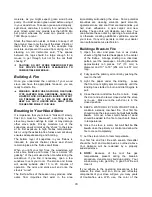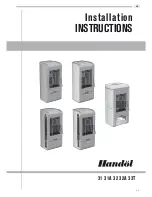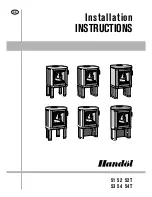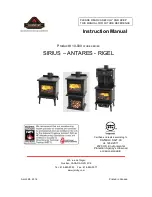
15
Figure 12
Connection to a Masonry Chimney
Consider two primary elements when connecting
your stove to a masonry chimney: the chimney itself
and the thimble where the stovepipe connects to the
chimney. Use only Code approved masonry
chimneys with a flue liner. See figure 13 for
instructions on installing a thimble into a masonry
chimney or masonry fireplace.
Before connecting to a masonry chimney, hire a
professional to examine the chimney for cracks,
loose mortar, and other signs of deterioration and
blockage. If the chimney needs repair, complete
them before installing and using your stove. Do not
install your stove until the chimney is safe for use.
Make sure the chimney’s cleanout is complete and
working properly. To avoid a loss of draft, the
cleanout must close off completely. If not, the
chimney will cool, your stove will perform poorly, and
creosote will build up in the chimney.
Make sure the size of the chimney’s flue is
appropriate for this stove and that it is not too large.
Use a masonry chimney
with an 8” x 8” (203 mm x
203 mm) tile size for best results. An oversized flue
will contribute to the accumulation of creosote.
Minimum Requirements:
At least 3’ (0.91 m) higher than highest part of roof
opening through which it passes and at least 2’ (0.61
m) higher than any part of the roof within 10’ (3 m).
Use the following checklist to ensure that your
masonry
chimney
meets
these
minimum
requirements:
Chimney wall construction:
Brick or modular block at least 4” (102 mm)
thick.
A rubble or stone
wall at least 12” (305mm)
thick.
Flue liner:
Minimum thickness of 5/8” (16 mm).
Installed with refractory mortar.
At least 1” (25 mm) air space.
An equivalent flue liner must be a listed chimney
liner system meeting type HT requirements or
other approved material.
Interior chimney requirements:
At least 2” (51 mm) clearance to combustible
structure
Fire stops must be installed at the spaces where
the chimney passes through floors and/or
ceiling.
Insulation must be 2” (51 mm) from the chimney.
Exterior chimney requirements:
At least 1” (25 mm) clearance to combustible
structure.
Chimney height requirements for both
prefabricated metal and masonry chimneys:
(See
Figure 13)
At least 3 feet (0.9 m) higher than the highest
part of the roof opening through which it passes.
At least 2 feet (0.6 m) higher than any part of the
roof within 10 feet (3 m) measured horizontally
from the top of the chimney.
This stove requires a minimum chimney height of 13
feet (4 m). The maximum allowable chimney height
is 30 feet (9m).
Summary of Contents for 8012
Page 2: ...2 Intentionally Blank ...
Page 12: ...12 Figure 9 ...
Page 16: ...16 Figure 13 ...
Page 28: ...28 Safety Label ...















































